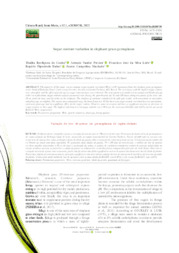Sugar content variation in elephant grass germplasm.
Sugar content variation in elephant grass germplasm.
Author(s): CUNHA, T. R. da; PEREIRA, A. V.; LEDO, F. J. da S.; DAHER, R. F.; MACHADO, J. C.
Summary: The objective of this study was to estimate sugar content variation (°Brix) in 95 accessions from the elephant grass germplasm active bank of Embrapa Dairy Cattle research center, located in Coronel Pacheco, MG, Brazil. The accessions with the highest sugar content were identified, and the effect of plant age on sugar concentration was evaluated. The experiment was conducted in randomized blocks design with two replications. Sugar content analysis occurred twice during the growth-cycle (at 70 and 100 days) along two points of the stem, one 30 cm from the base and the other at the midpoint. The analysis of variance considered the split plot model, with accessions as main plots and plant age as subplots. The means were compared using the Scott Knott test. While there was sugar content variation between accessions, increased plant age had no significant effect on the sugar content. However, some accessions did have a significant increase or decrease in sugar content as they aged. The highest and lowest mean sugar content was 6.96% (in the accession BAG80) and 4.03% (in the accession BAG13) °Brix, respectively
Publication year: 2022
Types of publication: Journal article
Unit: Embrapa Dairy Cattle
Observation
Some of Embrapa's publications are published as ePub files. To read them, use or download one of the following free software options to your computer or mobile device. Android: Google Play Books; IOS: iBooks; Windows and Linux: Calibre.
Access other publications
Access the Agricultural Research Database (BDPA) to consult Embrapa's full library collection and records.
Visit Embrapa Bookstore to purchase books and other publications sold by Embrapa.

